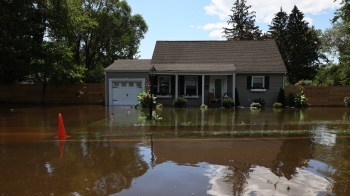Beth Rice lives with her husband in a one-bedroom rental on the 11th floor of a luxury high-rise in New York’s financial district.
Three thousand dollars a month buys her floor-to-ceiling windows in the living room and a view of the East River. The apartment has a kitchen she loves to cook in and enough space for her to read in one room while her husband’s on the computer in another.
But when Hurricane Sandy sent salt water flooding through 2 Gold Street, where Rice lives, it fried the building’s electrical systems and spread a strong gas odor throughout the building.
So while much of Manhattan begins to return to business as usual after the storm, Rice, 42, and her husband spent last week holed up in a 90-square-foot Midtown hotel room for $165 a night.
“It’s not, let’s say, soundproof,” she said, gesturing to the frosted glass bathroom that’s uncomfortably close to the bed. “Thankfully, my husband and I have been together for a long enough time.”
TF Cornerstone, the management company for 2 Gold Street, estimates it could be at least two months until Rice and her neighbors can return home.
There are roughly 65 large office and residential buildings in lower Manhattan in a similar situation because of problems with the building’s internal systems, according to Con Edison. The buildings must make repairs before the utility can restore power.
“The problems seem quite different building to building,” said Lockhart Steele, a founder of the real-estate blog Curbed that has been crowd-sourcing information from tenants about affected buildings.
“That has so much to do with how much sea water the building took on and basically where the equipment was positioned in the building,” he said, “so some buildings might have relatively minor damage or only have to replace a couple systems while others may have to replace everything.”
Communication from buildings about how long repairs will take has also varied widely, leaving many tenants feeling frustrated.
“We’ve been planning day by day,” said Steele, whose own building in the South Street Seaport’s Historic Front Street development was also flooded. “We just moved to [planning] week by week and we have our eyes set on month to month.”
Heather Hansen is in a similar holding pattern. She too lives at 2 Gold Street. She, her boyfriend and two roommates live on the 23rd floor in a three-bedroom apartment, paying a total of $5,000 a month. But for much of the first two weeks after the storm, she commuted into the city from her parents in Central New Jersey – two hours each way.
“My parents live in a retirement community,” said Hansen, 26, who works in television production. “So me and my boyfriend are sharing the bed — which we never slept together in the same bed at my parents house, but they’re allowing it because of these emergency situations now.”
Now Hansen’s competing against everyone else who’s been displaced by the storm and is looking for housing.
“I mean none of the sublets are going to be like home,” said Hansen. “We might find a studio, [but] we might still have to get roommates, which is not really optimal.”
TF Cornerstone has already said that tenants won’t have to pay rent during the time they aren’t able to live in the building. They’re also letting tenants break their leases without any penalties if they simply want to move.
But Hansen and Rice both said they’re going still figuring out what to do next. After all, without electricity to power the elevators in their apartment towers, most of their possessions and all of their furniture are trapped in their sky-high apartments.
There’s a lot happening in the world. Through it all, Marketplace is here for you.
You rely on Marketplace to break down the world’s events and tell you how it affects you in a fact-based, approachable way. We rely on your financial support to keep making that possible.
Your donation today powers the independent journalism that you rely on. For just $5/month, you can help sustain Marketplace so we can keep reporting on the things that matter to you.


















